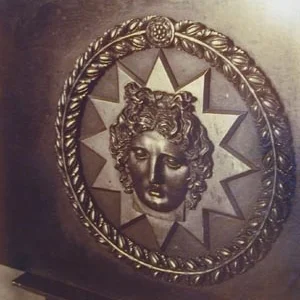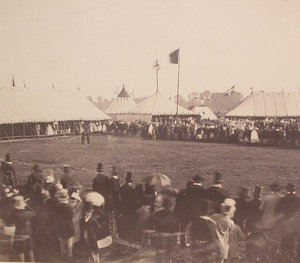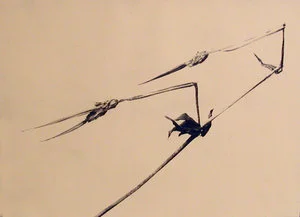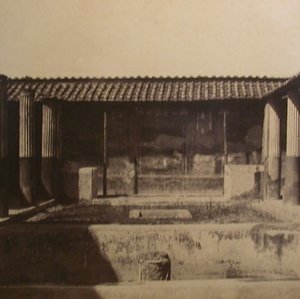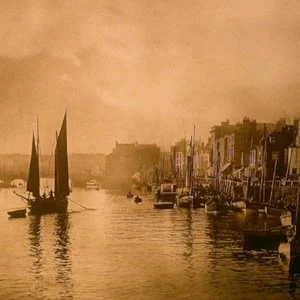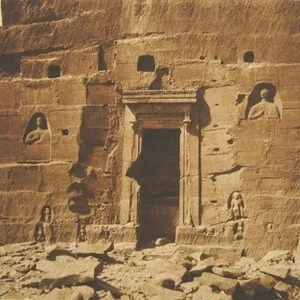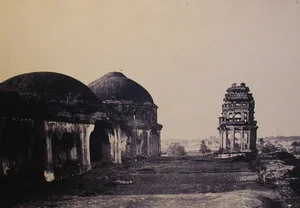The work of Eugène Atget is one of the richest pictorial embodiments of French culture. Working as a photographer mainly in and near Paris from the late 1890s until his death in 1927, Atget made a total of about 10,000 individual images. Over the course of his long career he discovered and progressively mastered photography’s capacity to transform plain fact into visual poetry. In the rapid unfolding of modernist photography in the late 1920s and early 1930s, Atget’s work soon became the exemplar of the medium’s new creative power. No major photographer in the half-century following his death was untouched by Atget’s influence. At his death in 1927, the French government purchased a portion of Atget’s negatives; the remaining contents of his studio and greater body of his work were purchased by photographer Berenice Abbott and art dealer Julian Levy. Carefully looked after by Abbott, the collection was later sold to the Museum of Modern Art.
Read MoreÉdouard Baldus was born in 1820 in France and worked as a painter in the 1840s photography peeked his interest. He was a founding member of the Societe Heliographique and an important influence to the art of heliogravure, a photomechanical process. He used the calotype process from 1851 and began using collodion wet-plate negatives and albumen prints in 1956. A pioneer of the photographic medium, he documented architectureal monuments of France as well as landscpes, paintings and the documentation of the Rhone Floods. In 1851 he was commissioned by the Comite des Monuments Historiques to photograph monuments in Paris, Fontainebleau, Burgundy, the Dauphine, Normandy, Auvergne and Provence. During 1854-1855 Baldus created 1,500 photographs of a new wing of the Louvre in Paris and was commissioned by Baron James de Rothschild to photograph the railroad lines in France.
Read MoreGustave Le Gray has has been called the most important French photographer of the nineteenth century. Trained as a painter under Paul Delaroche, Le Gray made his mark in the emerging medium of photography. An experimenter and technical innovator, Le Gray pioneered the use of the paper negative in France and developed a waxed-paper negative that produced sharper-focus prints. In 1851 he began to use collodion on glass negatives, which further increased the clarity of his images. He became one of the first five photographers, along with Édouard-Denis Baldus and Hippolyte Bayard, to work for the missions héliographique, a government-sponsored commission to document the state of repair of important French monuments and buildings. He was also a founding member of the Société Héliographique, the first photographic organization in the world. In the early 1860s he toured the Mediterranean with Alexandre Dumas. He spent his last years in Lebanon and finally Egypt, where he became a professor of drawing and where he died, in 1884.
Read MoreCharles Marville was initially trained as a painter, engraver and illustrator before he became a landscape and architecture photographer. Many of his works were made in Italy, Germany and Algeria. He was commissioned to document some of the ancient architecture in Paris during the 1850's and was hired by the Musee du Louvre to make reproductions of artwork in the collection. Marville was made the official photographer in Paris in 1862.
Read MoreThis important English photographer pioneered work in photographic studies of motion and in motion-picture projection. He emigrated to the United States as a young man but remained obscure until 1868, when his large photographs of Yosemite Valley, California, made him world famous. Muybridge's experiments in photographing motion began in 1872, when Leland Stanford hired him to prove that during a particular moment in a trotting horse's gait all four legs are off the ground simultaneously. His first efforts were unsuccessful because his camera lacked a fast shutter. The project was then interrupted while Muybridge was being tried for the murder of his wife's lover. Although he was acquitted, he found it expedient to travel for a number of years in Mexico and Central America, making publicity photographs for the Union Pacific Railroad, a company owned by Stanford.
Read MoreCarleton Watkins’ position as a preeminent photographer of the American West is undisputed. He is considered by many to be the greatest American photographer of the nineteenth century. During his career of some fifty years, Watkins traveled the western US, making thousands of remarkable, historically important images. From breathtaking pictures of Yosemite, the Pacific Coast, and the scenery along the Columbia River, to the vast Sierra Nevada, these images provide an unparalleled visual record of the West. Watkin’s artistic vision was both refined and evocative. It is in large part due to the persuasive power of Watkin’s mammoth plate images of Yosemite that the area was set aside as a National Park.
Read MoreEdward Weston, an American photographer was born in Highland Park, Illinois. Weston began to make photographs in Chicago parks in 1902, and his works were first exhibited in 1903 at the Art Institute of Chicago. Three years later he moved to California and opened a portrait studio in a Los Angeles suburb. The Western landscape soon became his principal subject matter. In the 1930s, Weston and several other photographers, including Ansel Adams, Imogen Cunningham, and Willard van Dyke, formed the f/64 group, which greatly influenced the aesthetics of American photography. In 1937, Weston received the first Guggenheim Fellowship awarded to a photographer, which freed him from earning a living as a portraitist. The works for which he is famous–sharp, stark, brilliantly printed images of sand dunes, nudes, vegetables, rock formations, trees, cacti, shells, water, and human faces are among the finest of 20th-century photographs; their influence on modern art remains inestimable.
Read More